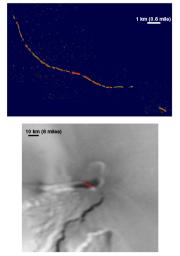
|
Pele’s Hot Caldera Margin
- Click the image above for a larger view
- Full-Res JPEG (682 x 970) (44.1 kB)
- Full-Res TIFF (682 x 970) (290.8 kB)
Caption:
The volcano Pele glows in the night in this close-up image of Jupiter's moon Io, obtained by NASA's Galileo spacecraft in the closest-ever Io flyby on October 10, 1999. Only surfaces hotter than 600 degrees Celsius (1,100 degrees Fahrenheit) are visible in this image. The hot material forms a thin, curving line more than 10 kilometers (6 miles) long and up to 50 meters (150 feet) wide. Galileo scientists believe that the changes in brightness along the curving line are due to variations in the amount of hot lava exposed at the surface. Data acquired previously suggest that the liquid lava at Pele is over 1,200 degrees Celsius (2,200 degrees Fahrenheit). Such lava would cool and become invisible in this image in just a few minutes. Therefore, this image outlines parts of the volcano that are at most a few minutes old.
The outline of the fresh, hot material is superimposed on the best daytime image of Pele (bottom), showing that the hot material follows the margin of Pele's caldera. A caldera is a depression caused by collapse during a volcanic eruption. Galileo scientists hypothesize that the Pele caldera is filled with liquid lava, with the floating crust broken-up along the margins where it hits the cliffs along the caldera's walls. The lava lake is probably confined to the dark, southern part of the Pele caldera, which covers an area of about 15 by 10 kilometers (10 by 6 miles). Previous data collected by Galileo indicate that hot material covers only an area of about 800 by 800 meters (0.5 by 0.5 miles). This suggests that most of the lava lake is covered by a cooler crust that floats on top of the molten lava. The behavior of this lava lake is similar to that of Hawaiian lava lakes, although Pele covers an area several thousand times larger than the lakes in Hawaii. Interestingly, the image of Pele's caldera obtained by Galileo in October shows only about one-percent of the hot area was known to be on the volcano . This indicates that 99-percent of the activity at Pele is in a region that was not imaged in this flyby.

Pu'u O'o lava lake, Hawaii, 1992
North is to the top of the picture and the sun is on the other side of Io. It is centered at 18.6 degrees south latitude and 255.7 degrees west longitude, looking obliquely at an area approximately 10 kilometers (6 miles) by 10 kilometers (6 miles) in size. The picture has a resolution of 30 meters (100 feet) per picture element and is taken in the clear filter using a 45.8 millisecond exposure time. The images were taken by the camera onboard Galileo from a range of about 1,400 kilometers (840 miles).
Background Info:
The Jet Propulsion Laboratory, Pasadena, CA manages the mission for NASA's Office of Space Science, Washington, DC. JPL is a division of the California Institute of Technology, Pasadena, CA.
This image and other images and data received from Galileo are posted on the World Wide Web, on the Galileo mission home page at http://solarsystem.nasa.gov/galileo/ . Background information and educational context for the images can be found at http://galileo.jpl.nasa.gov/gallery/io.cfm .
Cataloging Keywords:
| Name | Value | Additional Values |
|---|---|---|
| Target | Io | |
| System | Jupiter | |
| Target Type | Satellite | |
| Mission | Galileo | |
| Instrument Host | Galileo Orbiter | |
| Host Type | Orbiter | |
| Instrument | Solid-State Imaging (SSI) | |
| Detector | ||
| Extra Keywords | Color, Volcano | |
| Acquisition Date | ||
| Release Date | 1999-11-19 | |
| Date in Caption | 1999-10-10 | |
| Image Credit | NASA/JPL/University of Arizona | |
| Source | photojournal.jpl.nasa.gov/catalog/PIA02511 | |
| Identifier | PIA02511 | |
